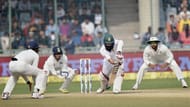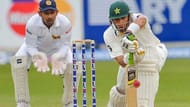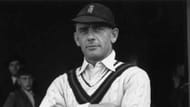
Stonewalling is not new in Test cricket. We do not have ball-by-ball data from the early days of Test cricket, but even then, such was the impact of batting of some of the players from that era, that they were termed as 'stonewallers'.
The likes of William Scotton, Bobby Abel, Dick Barlow and Alick Bannerman were renowned stonewallers in the 19th century.
Barlow once opened the batting, scoring only five runs in 87 four-ball overs as he ran out of partners, and the team folded for 69 all out in 87 overs, with the opener not out on 5!
Alec 'The Rat' Bannerman once scored 91 runs off 620 balls in a Test match. More than 90% of the balls he faced were dot balls!
Even in the 20th century, there were some notorious stonewallers. The Nawab of Pataudi Sr. once batted so slow in a Test match in Australia, that he invited plenty of sledging from the Australian crowd.
Post-war, Trevor 'Barnacle' Bailey carried the tradition well. He scored 68 off 427 balls in 458 minutes in the Brisbane Test during the 1958-59 Ashes. Pressmen kept themselves entertained by betting on how many balls he would take to score the next run.
Post-war Australian captain Lindsay Hassett took a long time batting in the 90s before scoring his maiden Test hundred. His brother was due to get married in the local church. He waited for 10 minutes with Hassett on 96 but then left for the marriage.
He came back to hear that Hassett was batting on 97. Hassett later used to joke that he got his hundred before they went for their honeymoon!
Then we had the Geoffrey Boycotts, the Mudassar Nazars, the Bill Lawrys and the Chris Tavares. The stonewallers sure bore a lot of people but do add a different dimension to the game.
A Cheteshwar Pujara or a Rahul Dravid can be expected to do that, but let's look at some famous incidents of stonewalling from players who are not really known for that.
Hashim Amla

Opposition: India
Venue: Feroz Shah Kotla in Delhi
Season: 2015-16
Twin centuries from Ajinkya Rahane left the South Africans with an uphill task of scoring 481 in the fourth innings to win the Delhi Test, on a pitch that was helping the Indian spinners. They had to bat out five sessions if they were to save the match.
Ishant Sharma and Ravi Ashwin opened the bowling for India and in the last ball of the fourth over, Dean Elgar was dismissed.
Enter Hashim Amla.
Ishant, Ashwin, Ravindra Jadeja and Umesh Yadav all were brought into the attack in that post-lunch session but none of them could breach through Amla's defence.
He defended soundly but, rather ironically, the first false stroke brought him a couple of runs off an inside edge, after he had faced 45 balls.
He scored his sixth run of the session after facing 75 balls. Subsequently, he once again went into shut down mode for the rest of the session. He faced another 38 balls in that session without adding any more runs to his score.
39 overs were bowled in that particular session of play. Amla was there for 35 of them. He scored 6 off 113 balls.
He eventually scored 25 off 243 balls before being dismissed by Jadeja. South Africa scored 143 off 143.1 overs but lost the match.
Misbah-Ul-Haq

Opposition: Sri Lanka
Venue: Sharjah
Season: 2011-12
It is probably safe to say that Misbah-ul-Haq has been an enigma. He made a late comeback to the national team, became the captain, reached unprecedented heights, and then quietly bowed out in the shadow of Younis Khan.
He could bat according to what the situation demanded. He could hit sixes almost at will and could even defend the half-volleys when he wanted to do so.
Kumar Sangakkara batted beautifully in both innings to give Sri Lanka a slim chance of winning the match. Sri Lanka did waste time before declaring their second innings but they still had 61 overs to get Pakistan out. On the other hand, Pakistan needed to score 255 to win. No one expected them to go for the win though.
Younis Khan, the century-maker in the first innings, was dismissed in the 27th over, giving Sri Lanka a glimmer of hope. Misbah replaced Younis and started in a positive manner. He was on 4 off 7 balls when the session's play ended. Sri Lanka needed seven wickets in the final session of the decider.
When Misbah came out to bat after tea, he showed no intentions of scoring any run. He dead-batted most balls on the stumps and left anything which was slightly wide. He handled Rangana Herath's spin effectively as the doors were slowly shut in front of Sri Lanka. Misbah eventually ended with 5 runs off 69 balls in the entire session of 28 overs.
It saved the day for Pakistan. Don't forget that the same person once hit the fastest century in Test cricket!
Sachin Tendulkar

Opposition: South Africa
Venue: Cape Town
Season: 2010-11
The India-South Africa series in 2010-11 was probably the closest between these two teams on the South African soil. In the deciding Test at Cape Town, Jacques Kallis scored centuries in both innings to put South Africa in an advantageous position. They declared at the end of day 4, setting a target of 340 for the visitors on the final day.
It was evident from the 5th morning that India were not going for the runs against the trio of Dale Steyn-Morne Morkel-Lonwabo Tsotsobe. Virender Sehwag went early but then Rahul Dravid and Gautam Gambhir steadied the ship and batted out vital time.
Dravid was finally dismissed with 41 overs still to be bowled in the day. Sachin Tendulkar, fresh from a fine century in the first innings, replaced him in the middle.
Tendulkar had reached 7 off 22 balls when tea was taken. 34 overs were still to be bowled on the fifth-day track. Things became trickier when the well-set Gambhir was dismissed six overs into the final session.
VVS Laxman joined Tendulkar in the middle. While Laxman tried to score off the loose balls, Tendulkar was in a completely defensive mood. He scored 7 runs in the session off 69 balls before play was called off with India on 166-3 after 82 overs.
The Master Blaster could adapt to all possible situations when required.
Cyril Washbrook

Opposition: West Indies
Venue: Lord's
Season: 1950
Cyril Washbrook is best remembered for his comeback to the England team after five years for the 1956 Ashes and for making a fairytale 98 in his first innings of that series. But Washbrook was a very solid top order batsman even before the war.
The war robbed him of his best years and when cricket resumed in 1946, Washbrook became a regular in the England team. He had his best years over the next five seasons, before going into a steady decline as a batsman.
This series marked the emergence of West Indies cricket. The famous spin-twin of Alf Valentine and Sonny Ramadhin tormented the English batsmen throughout this series. The second Test at Lord's was no exception. Ramadhin and Valentine took 18 wickets between them to take their team to a 326-run win.
West Indies declared their second innings early on day 4. They had set England a massive 601 to get in a little over 5 sessions. Everyone knew the result even before England started their second innings. But Washbrook was among the ones who never gave up.
At the end of day 4, he was still there batting on 114, with England on 218-4. We would never know what he thought that night but when he came out to bat the next morning, his approach towards batting had changed completely. He was in a mood to defend everything the West Indian spinners threw at him.
On that 5th morning, Ramadhin bowled 10 consecutive maidens to Washbrook, batting on 114! He faced 66 balls that morning before being eventually dismissed by Ramadhin. He didn't add to his overnight tally of 114. This has to go down as one of the strangest innings in the history of the Test cricket.
Follow IPL Auction 2025 Live Updates, News & Biddings at Sportskeeda. Get the fastest updates on Mega-Auction and cricket news
